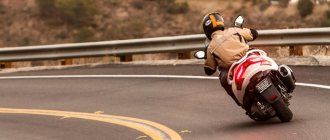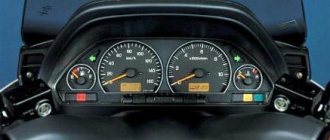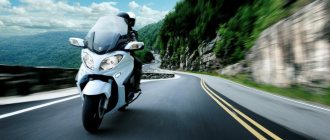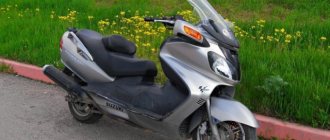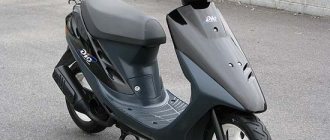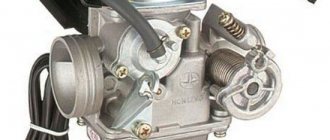Fast civilian or near-sport motorcycles are not always convenient in everyday life. As practice shows, relatively low-speed maxi-scooters in the city and on the highway are many times superior to the vast majority of motorcycles in terms of comfort and traffic intensity. Today we’ll look at the trendsetters of the genre - as a vehicle with mileage and history, let’s take the Honda FJS 600 Silver Wing of the 2001-2008 model, and as a current analogue - the most modern existing Suzuki AN 650 Burgman.
Honda FJS 600 Silver Wing (2001–2008, RUB 120,000–300,000)
The first generation Silver Wing in the 600 cc version is one of the most popular and in demand maxi-scooters. The model has long been discontinued, but the popularity of the Japanese “sofa” with a memorable diamond-shaped headlight has only grown over the years.
Engine
The 582cc eight-valve parallel twin with electronically controlled fuel injection and liquid cooling is fantastically reliable. It does not consume oil even in the most advanced cases. No sores or weak points were noticed. With adequate maintenance, the engine can easily last 100,000–150,000 km without major repairs.
Transmission
The CVT transmission is designed as is, with absolutely no bells and whistles. Which has a positive effect on resource and reliability. The mechanism is similar to that of a fifty-kopeck scooter. Weights, pulleys and belt. Nothing more! The result is a non-violent character (for fans of dynamics, it makes sense to sharpen their skis in the direction of expensive tuning), which is more than compensated by reliability that borders on the fantastic.
Frame and body kit
At the current time, the frame design can already be called obsolete. The spatial steel part does not have sufficient rigidity, which does not have the best effect on handling.
Silver's plastic is dense and thick. The abundance of mounting eyes is not the best for long-term use. Fasteners often suffer during repairs; plastic parts begin to rattle and join with an uneven gap.
Brakes
The braking system is Silver's strong point. Despite the absence of a second brake disc on the front wheel. All 600 cars are equipped with a combined brake force distribution system. When you press the front brake lever, the two pistons of the front caliper are activated. Pressing the rear brake lever activates one front caliper piston and two rear caliper pistons.
Pendants
The chassis of the Honda FJS 600 Silver Wing, so to speak, is designed strictly according to scooter canons. Without introducing solutions from the world of cubic motorcycles. The fork is short and flimsy, without additional yokes. Hence the lack of rigidity, which, together with a not very monumental frame and a simple rear suspension with two shock absorbers, reduces the “driver’s” to a minimum. The suspension is generally strong and reliable, but unlike many competitors, it is not conducive to active, almost sporty driving. It is worth paying attention to the mounting ears of the rear shock absorbers and the engine-frame “rocker”. Driving on roads of poor quality may cause serious gaps and cracks in these places.
Comfort
The standard windshield on the Honda FJS 600 Silver Wing is large, but not adjustable. Tall drivers will have to order aftermarket windshields or additional add-on sections. The suspension, despite its incapacity for hyperactive steering on uneven surfaces, behaves extremely adequately. The scooter passes through potholes, joints and other misunderstandings smoothly and softly. Tall drivers may feel uncomfortable driving the Silver. An individual with a height of over 190 cm is guaranteed to rest his knees on the front panel.
Modifications
Silver Wing debuted in 2000. There are two cubic capacity options at once - 400 cm3 and 600 cm3. In 2002, the relay regulator was moved under the fairing. In 2003, a “Mode” button appeared, allowing you to slightly “cheer up” the injection maps, and ABS also appeared as an option. In 2004, a slight restyling took place - the shape and fastening of the glove compartment lids changed, the headlight reflector housing became chrome-plated, the material of the seat upholstery changed, the instrument panel lighting became brighter, the lower fork cups and rims began to be painted black. In 2006, an immobilizer and side lamps in the headlight appeared, and the display backlight on the dashboard became blue. In 2008, Honda polished up the Silver for the last time before the generation change. Distinctive features are gold-colored wheels, calipers and nameplates, as well as carbon-fibre seat trim. In 2009, the design was radically updated, and changes were made to the engine.
Motorcycle Honda SW-T 600GT Silverwing 2010 review
The Silver Wing combines ease of use, comfort and the power of a custom-designed 600cc liquid-cooled twin-cylinder engine. Silver Wing provides comfort comparable to a car, but unlike a car, it easily avoids the problems of traffic jams and parking in the city. The Silver Wing is equipped with a modern and very compact engine with fuel injection and in-line cylinder arrangement, which provides an instant surge of power and acceleration. The rigid frame and suspension give the motorcycle ease of handling comparable to a sports bike. All this, combined with a modern and reliable braking system, brought the Silver Wing model universal recognition and a large number of fans who appreciate the pleasure of riding luxury scooters.
I can’t say that I have a warm attitude towards scooters - neither their small wheels nor the fairly fumes of two-stroke bikes inspire confidence. The absence of a frame in the normal sense, the sitting position as if on a chair - all this is specific and certainly does not contribute to good handling. Therefore, when flying to Novosibirsk to test the brand new Silver Wing, I did not experience any unusual feelings. Especially remembering the local roads, the quality of which is far from ideal. However, the scooter was intriguing in some ways - for example, the four-stroke two-cylinder engine with two balancer shafts driving the massive machine promised low vibration levels and quiet operation. And the 49 “horses” contained in its depths implied the presence of acceleration dynamics close to those of a motorcycle.
Luxury finishing, large luggage capacity and glass, behind which you can ride even in a light jacket - in everything, the continuity of a business class scooter with touring motorcycles. A combined braking system and the usual handbrake for a “maxi”, two backrests and a chopper position behind the wheel... Solidity emanates from everywhere. Quite an automobile dashboard successfully combines an analogue speedometer and tachometer with a digital odometer, temperature and fuel indicator in the tank. Modern design! Even on a sunny day, all readings and indicator eyes are perfectly readable - they are “recessed” in “wells”.
The driving position is close to a chopper thanks to the forward footrests and high steering wheel. The driver's mini backrest is adjustable back and forth. In a word, they took care of ergonomics. The passenger can also be envied - he is not deprived of comfort. Of course, the Silver Wing is not a Gold Wing, but I note that other motorcycles are not equipped with such “chairs”... However, there is something to be sad about. I respect Japanese auto and motorcycle manufacturers for the perfect fit of the plastic cladding. Silver Wing gets no more than a C plus in this parameter - uneven seams are unacceptable on a “toy” for $11,000!
Fuel injection is the norm on modern motorcycles, and no pre-start enrichers! The engine starts, I see on the tachometer that the idle speed is increased - warming up. Is it already working? A huge “can” suspended on the right muffles the exhaust sound so effectively that it is difficult to distinguish the characteristic two-cylinder “voice”. But here’s the problem: I’m sitting behind the wheel, carefully turning off the gas, moving away and... momentarily losing the sense of reality. Having decided to turn around on a small patch, I almost fell. The glass concave inward noticeably distorts the panorama in front of the front wheel, which in itself is very unpleasant. However, you get used to this feature almost immediately.
I twist the throttle and after a slight “variator” delay I receive a noticeable push in the lower back - the scooter has begun to accelerate. The impressions are not at all motorcycle-like: firstly, the dynamics are worse than those of 400 cc choppers - 7.8 s to 100 km/h. Secondly, there is no connection with reality in the form of contact with the oncoming flow. I admit, I haven’t driven any other Maxis, but this Honda really struck me as having such a non-motorcycle feel. Once about seven years ago, when I first rode a Gold, I thought that the car was a good thing, and quickly mastered the four-wheeled achievement of civilization. Now I felt something similar. On the Silver, I would like to have side wheels so as not to expose my legs during low-speed maneuvering.
Another thought that came to my mind after a short time: “And the scooter can be solid!” Yes, in general, this is not a scooter. You don’t have to worry about slalom between cars - the Silver is not really designed for that. However, you don’t have to worry about anything else. The power reserve allows you to completely forget about possible speed losses during maneuvers. Let me explain to those who are not familiar with low-power technology. Let’s say you’re driving in the left lane of traffic at 90 km/h (this speed is allowed by any “weaving” scooter) and there’s a traffic jam ahead. The cars stop, but you abruptly change lanes to the right without reducing your speed - after all, you don’t want to waste a whole 10 minutes gaining speed? There is a thrill in this, but not everyone likes it: in some situations it is safer to reduce the speed without changing lanes. Especially if someone fast behind you wants to do the same maneuver. There are no problems with the “silver”: I braked and accelerated. Everything is in order with its deceleration - the combined braking system knows its job perfectly.
In a city ri, which you no longer want to call a scooter, it’s like a fish in water. Allows you to move with a slight advance of the flow. No one is surprised by this, no one tries to cut it - the silver thing with bright headlights looks expensive. You don't ride on it, you slide. I tried it and realized that it’s better not to experiment with sudden lane changes; the geometry of the chassis and the grip of the tires on the asphalt are obviously not designed for this. Soft suspension, long wheelbase, comfortable seating – everything allows you to relax behind the wheel.
But not for long. As soon as smooth asphalt gives way to broken asphalt, you understand that Russia is not Europe, and Novosibirsk is not Munich. The chassis of a scooter is not designed for this: small wheels, thin frame tubes... Of course, the “silver” is more stable than its smaller brothers, equipped with 10-inch wheels and almost completely devoid of a frame (at least here the tunnel between the legs is high), but not so much to move confidently along our sometimes terrible roads.
Here it is correct to compare it not with scooters, but rather with choppers. To complete the picture, I rode a Honda Steed 400 and a Suzuki VS400 Intruder. Alas, the Silver Wing is more unstable on bumps than any of these Japanese “Americans”. Another trouble: “silver” is like a rattle. Plastic lives its own life, creaking on bumps. There is no perfection in the world... If Honda didn’t do it, then who did? However, we’ll forgive this shortcoming; I don’t think that other “maxis” have anything fundamentally different. Leave Silver Wing aside? No way, especially since they didn’t try to accelerate.
The maximum speed exceeds 160 km/h (according to the speedometer - 170 km/h), but the car begins to frighten already at 120 km/h. Longitudinal and smooth waves of asphalt force you to slow down to the next flat section. But it’s not annoying to keep it at 140. The side wind doesn’t spoil the picture, the “silver” sails surprisingly little. Maybe it’s aerodynamics, or maybe it’s a low center of gravity.
“Silver” is an excellent tourist; not only a pair of normal “integrals” can easily fit under the saddle into a 55-liter (!) container. An impressive set of travel gear for a decent hike can easily fit there. And if you also look into the front glove boxes, your head will spin – for example, in the left one, which is locked with a key, a liter plastic bottle fits.
You can’t go out into nature on this one - small wheels, a long wheelbase and low ground clearance, supported by more than 200 kilograms of weight, discourage any desire to leave the asphalt. But on the road, nothing will stop you from racing hundreds of kilometers without stopping, regardless of weather conditions! Such comfort on a long journey will make you close your eyes to the identified shortcomings and think about scooters differently. After spending several hours in the saddle, you notice other pleasant little things. For example, a very low level of aerodynamic noise. Everything is learned by comparison - I noticed this when I rode a motorcycle for a change.
Summing up the results of the test, I’ll try to understand what attracted the new “maxi” from Honda. First of all, a completely different ride quality. The Silver Wing has the potential to completely redefine the concept of two wheels. A motorcyclist is unlikely to ride such a machine, except perhaps one who wants to take a break from the excess power of a sportbike and chopper pseudo-comfort. Silver Wing is able to introduce people who are far from bikes, bikers and night rides with the roar of tuning mufflers through the city center into the motorcycle theme. Moreover, it should be fully introduced, opening up the same horizons for a potential maxi-scooter rider as for a motorcyclist. Unless it will impose light restrictions on driving on broken roads. Which, by the way, is not very pleasant to ride on a motorcycle.
“Silver Wing”... In the early 80s, this was the name of the “suitcased” touring version of the two-cylinder CX500, known in our country as the “Japanese boxer”, and in the West as the favorite car of motorcycle couriers. In the fall of 2000, this name was given to the largest maxi-scooter at that time. A year later, the even more “large-caliber” Suzuki Burgman 650 appeared, but to this day Honda retains its primacy in wheelbase (1595 mm), maximum speed (according to various independent experts, 161-164 km/h), and in some European countries ( and also in Russia) – and at retail price. The latter is more than strange: there is no trace of the electronic control of the variator, nor the “guitar” of the final drive gears on the “Wing”. Although the car is more complex than, say, the Majesty 250. The engine is two-cylinder, four valves per cylinder, injection. And most importantly, there is a clever connection with the transmission, thanks to which the variator is combined “scooter-style” with the pendulum, and the engine itself rests in the frame, like in motorcycles. Otherwise, it’s a typical “self-propelled sofa”, only very large: length 2275 mm, which is even longer than the mentioned “Big Burger”, and only slightly less than the “large-wheeled” Aprilia Scarabeo 500.
But what really makes Silver Wing valuable is that it is the only “hypermaxi” that can be quite freely purchased used. No other device of this class has taken root in Japan (and imports from Europe are expensive, like devices previously purchased in Russia), “little Golda” is a frequent guest in the price lists of salons selling second-hand goods. Moreover, the price is quite acceptable, especially considering that the official dealer is asking $14,900 for a new copy. However, the new versions have been equipped with ABS for the second year already, and the color range will be richer. And the 400 cc 38-horsepower version (its designation is NF-01) will not be sold under the guise of a “six hundredth” (PF-01). So look carefully at the VIN when purchasing. We got a 2002 copy for testing with a mileage of 24,000 km. “Fresh” enough (although it’s noticeable that it’s not new) so as not to make allowances for the technical condition of the car and get the most out of it.
I would never have thought that you could ride a scooter as fast as a motorcycle, and moreover, with comfort. And my friends: “Oh, you’re starting to get old…”, “It would be better for the same money to take a used 600!”... This is because they judge speculatively. But you need to “ride” a maxi-scooter to appreciate its advantages.
I went and compared. A sportbike is a provocateur, the word “evil” stuck to it for good reason. And then, he is a voracious gas guzzler. No matter how hard I tried to ride it “for pleasure,” I couldn’t get it. For me, driving something in between, and therefore the best, that exists between the clumsy “tourists” and compact “sports”.
One day, while “wandering” on the Internet, I came across an uncle’s diary, who sorted out the reasons for his decision to replace the 1800 cc Honda Gold Wing with the 600 cc Silver Wing. I was intrigued: what he presented turned out to be close to me. Having changed to a “silver”, the uncle, continuing to travel with his comrades, recorded mileage, fuel consumption, other costs... And described the thrill. Summarized: after a month of daily trips on the Silver Wing 600, a scooter with a CVT, with a seat “like on a stool” and a “plush” character, in his words, I absolutely did not want to return to the saddle of the venerable “Golda”... I believed what I read - and bought Silver Wing.
What is a buzz? This is what I discovered about the scooter's potential. But for this I had to drive it almost 3000 km.
The inline two-cylinder 582 cc engine with the PGM-FI electronic injection system never failed. It starts easily - from the first touch of the starter button, it runs smoothly, no extraneous noise. Two balancer shafts dampen all vibrations... Honda engineers have created an engine that is “not seen or heard.” However, this is an image. And if we talk about the real thing, the exhaust here is smooth, quiet bass.
I can’t imagine that driving a Silver will remain comfortable if the exhaust is equipped with a direct-flow muffler: they are incompatible! And I’ll add: the exhaust system is equipped with a catalyst, so the scooter meets the requirements of the Euro 3 standard.
After 16,000 km, I took it to a branded technical center for diagnostics. I was waiting for everything. However, the experts reassured us: the engine is like new, the valves do not need adjustment, the injector is clean, like a child’s soul, and synchronized. The experts gave important advice: do not lose the small black key to the anti-vandal lock - it is unique! You can only get a copy... with a new lock. I checked: you can close the lock with any hex key, but only “relatives” can open it.
Comfort vs reality
I had the opportunity to drive Silver cars of various years of production - from 2001 to 2007. There are no significant differences between them. The only thing that distinguishes those produced before 2003 is the absence of ABS. But even among the models of recent years coming from Japan, there are samples without an anti-lock braking system. But those that were supplied to the USA and Canada, and since 2003 to Europe, were supplied only with ABS.
The combined braking system is the chic feature of this maxi-scooter. If you press the left lever, both circuits are activated simultaneously, on the front and rear wheels. The forces on the brake discs are distributed approximately evenly: 60% on the front and 40% on the rear. The factory-set braking dynamics are sufficient to stop the 220 kg Silver Wing exactly where you want it to stop. But even without ABS, I only managed to skid the rear wheel a couple of times, and then only on slippery markings after the rain. All thanks to the large wheelbase -1590 mm and the location of the engine in the body of the device (it is lowered as far as possible and shifted towards the rear wheel).
The right lever controls only the forward circuit. If you press both at the same time, the brakes will bring the scooter down so abruptly that an unprepared pilot will be thrown from the “sofa” onto the dashboard. A “chopper” landing will help you avoid falling forward - this is when your legs are extended forward, with your feet resting on the stance (the manufacturer has prudently extended the rubber mats to the middle of its height). This way, chopper-style, it’s more convenient than simply placing your feet on wide platforms on both sides of the tunnel: sharp shocks back and forth during acceleration and braking are absorbed and are not annoying. And if you want to change your position, just move your feet to the platform - and you’re a traditional scooter rider again! And to complete the description of the seating position: the back of the driver's seat is also adjustable - it can be moved back and forth.
The instrument panel is simple and clear, with information on everything you need to know before, during and after a trip: tachometer, parking brake indicators, oil pressure indicators, CVT belt wear indicator, large yellow turn signal indicators and, finally, an easy-to-read dial speedometer in the center of the panel. The right side of the dashboard is the most valuable source of information. Here, fuel level, engine temperature, and mileage are displayed on one screen. There is also a clock here. The digital odometer has three independent memory cells: two temporary ones - with turning on and resetting the mileage counter and one - with the total mileage counter.
The centrifugal clutch “seizes” at approximately 1800 rpm. It’s not easy to “catch” constant thrust “from scratch” around 2000 rpm. The “uncertain” behavior of the Silver Wing at speeds up to 10 km/h will take some getting used to. The reason for this is not the speed, but the excessively soft suspension, especially the fork. At speeds above 20 km/h, the only thing that can affect the straightness of the ride is deep ruts in the asphalt. This weakness of the “silver” will be felt more acutely than others by those who switched to it from a motorcycle with its wide 17-inch wheels: those on this scooter (front - 14 inches, rear - 13) seem too small. And I advise you: it’s not worth experimenting with jumping onto longitudinal sections of asphalt. Regarding wheels for the practical rider, I’ll add: buying tires for the Silver Wing is easy, they are in stores.
V-MATIC: three gears as one
A traffic police inspector once stopped me to check my documents, and started asking: “Isn’t it scary on him?” - “Very scary, in first gear the acceleration is up to 160...” His eyes are wide open! I looked at the speedometer, and there was a marking on it up to 200 km/h. “And then how long will the second one be?!...” - “I don’t know, I haven’t tried it yet!”
I didn’t lie very much, but in the main, in essence, no. On the streets of the city, “silver” is king. I didn’t measure how many seconds it takes it to accelerate to “hundreds,” but up to 80 km/h it is capable of “making” any mass-produced car from a traffic light. Then the acceleration is no longer so bad. Honda has developed a very user-friendly “nearly continuously variable” V-Matic transmission. It seems that there is only one program, and it is for all occasions. The V-Matic actually has three modes: "city", "touring" and "full power". The engine control unit is connected directly to the gearbox and, depending on the driving mode, it calculates the quantity and quality of the mixture to be supplied to the combustion chamber. What this gives is illustrated by the numbers. On the highway, when the scooter travels for a long time at a constant speed (far from 80 km/h), consumption drops to 4.5 liters. In the city, where you often accelerate, unscrew the handle all the way, and then also sharply brake to zero, it increases to 6.5.
Slowly does not mean slow
The advantage of the Silver Wing 600 over 400 cc and 250 cc scooters of similar dimensions is the ability to comfortably (this is important) move at, mind you, 140 km/h. For a “silver”, this speed is cruising, at which the scooter does not strain or strain at all.
High glass provides excellent protection from wind blowing at any speed. Unfortunately, this grace does not extend to the passenger: the “second number” sits about 10 centimeters above the driver, and the entire flow of incoming air enters his helmet. Fighting the wind is tiring. Based on the results of the analysis, after several “non-stop flights”, the Formula of Absolute Comfort was derived (it is not necessary to create an abbreviation from the first letters) for the full crew: this is when the pilot, upon reaching a certain speed, is no longer bored, and the passenger is not yet blown away. So, if it’s just two of you, then you need to move at a pace of 120-130 kilometers per hour on the highway, and in city traffic - about 80 (if possible).
The Silver Wing 600 tank is spacious, 16 liters, and its contents are designed to last approximately 400 kilometers. This is ideal as described in the instructions for use. But the maximum I managed to achieve when driving “our” AI-95 was 300 kilometers. It’s a shame: every time they “break off” a hundred miles from what was promised.
A couple of years ago I had to urgently go to St. Petersburg on business (and therefore under my own power) on a heavy sports motorcycle. “Taking a quick flight” on an airplane would be much easier and, considering the collected package of receipts for paying fines for speeding, cheaper... After such trips, you understand why large touring motorcycles and even scooters such as the Silver Wing were invented. The recent trip on the Silver to St. Petersburg and back was like an easy country walk, and it took only half an hour more time than on the Sport two years ago. The explanation is simple: fewer stops along the way - higher average speed. If on a sportbike I had to stop three times to refuel and one more time just to stretch my stiff back and shoulders, then on the “silver” there were only two short pauses in riding. And there was no need to pay for exceeding the speed limit.
What does the new owner of Silver need to do?
The first thing is to equip xenon low beams - to improve your visibility in the dark, and so that the scooter becomes truly noticeable to car drivers. The operation takes no more than half an hour and requires virtually no electrical intervention. The huge headlight consists of two parts - low and high beam reflectors, containing H7 type lamps. It is most convenient to “settle” the control unit in the right “pocket” of the glove compartment. From here to the headlight in a straight line is no more than 20 centimeters, so there will be no difficulties with laying the wires.
Secondly, the program for preparing the scooter for everyday use should include light tuning of the fork. It is necessary to replace the oil in it with a thicker one, for example, with a viscosity of 15W, the “plushness” in the character of the maxi-scooter will decrease, and the handling will increase.
Third. Don’t be fooled by the volume of the trunk because it is intricately shaped; the 55-liter capacity can accommodate a helmet, a wheel lock, a raincoat or cover, a pair of gloves and, in fact, that’s all... So, I highly recommend installing additional panniers. Find them for the Silver Wing, complete with mounting platforms, in the catalogs of companies producing tourism accessories. The 40-liter, with a platform, is also included in the line of original Honda accessories.
Silver Wing – for the practical
Go to the entire range of Honda motorcycles, on this page you can find Honda SW-T 600GT Silverwing motorcycles of other years and information about them
Suzuki AN 650 Burgman (2013 – present, RUB 400,000–650,000)
It's hard not to notice Suzuki's passion for producing maxi-scooters. Specifically, “Burgmans” are present in all running cubic capacity ranges of 125–650 cm3. “650” is the flagship of the model range and at the same time one of the most comfortable maxi-scooters on the planet.
Engine
The strongly forward-inclined two-cylinder injection four-stroke liquid-cooled engine does not shake much with charisma, but it drives assertively and efficiently. In the world of maxi-scooters, it stands out for its impressive low-end thrust and top speed of around a record 200 km/h. This power unit produces little vibration; it begins to eat oil only in the most advanced cases. Mileages of 100,000 km or more with proper maintenance are not uncommon.
Transmission
The transmission of the Suzuki AN 650 Burgman is made according to a complex, rarely used design. The engineers who created it are great fellows, but there are, nevertheless, reasons for criticism. The classic V-belt variator in the case of the large “Burg” is equipped with an add-on in the form of electronic control via a servo drive. The electronic brain gives the scooter a quick response to turning the gas handle and efficiency. It is possible to switch to manual mode with five virtual gears, as well as switch to Power mode (analogous to sport mode). The weak point of the variator and, at the same time, the main problem of all AN 650 Burgman lies in the gear ratio control mechanism. The servo has two small all-plastic gears that interact with each other and with larger metal gears. Plastic tends to wear out and deform from high temperatures. As a result, the scooter may become immobilized at the most inopportune moment. No one can guarantee you how much longer the scooter will travel, 1000 km or 10,000 km. Repairing this sore in the field is not possible. Ideally, it makes sense to replace plastic gears with metal ones from third-party masters.
Frame and body kit
The complex steel frame and ornate steel rear subframe provide a robust design that requires no additional reinforcement. Thick plastic reliably protects the “internal organs” of the scooter in case of falls. Plastic parts in the most vulnerable areas are equipped with wear-resistant pads.
Brakes
The brakes of the Suzuki AN 650 Burgman could be the benchmark among maxi-scooters, if not for the weakness of the front and rear brake levers. This problem is solved by installing reinforced brake hoses.
Suspension
Despite the external gloss and advanced equipment, the Burgman is primitive in terms of suspension. There are no special complaints about the telescopic fork, which cannot be said about a pair of shock absorbers in the rear suspension. For such a bulky and cubic “sofa” the shock absorbers are nearly enough. Especially regarding torsional rigidity. When driving diagonally along serious irregularities, the scooter’s stern continually dances a very unpleasant dance, which can turn into a dangerous departure from the intended trajectory.
Comfort
Due to its considerable dimensions and thoughtful ergonomics, the Suzuki AN 650 Burgman comes close to luxury tourer motorcycles in terms of comfort. When driving in dense city traffic, the Burg may be too wide, but the engineers came up with a way out here too. Due to the servo-driven folding rear view mirrors, the dimensions of the scooter can be changed on the fly. Driving along the highway is a pleasure. Including due to the presence of an electric windshield.
Modifications
The current generation Suzuki Burgman 650 (production since 2013) is supplied to the market in two versions: standard and Executive. The second one is distinguished by heated handles and a backrest for the passenger. Both versions are equipped with an ABS system, which was previously installed only on the Executive version, and an Eco indicator on the dashboard.
Technical parameters of the model
The qualitative characteristics of the Honda Silver Wing 600 should be given, identifying its strengths:
| Dimensions (length; width; height) | 227.5; 77; 143 cm |
| Weight | 247 kg |
| Maximum speed | About 162 km/h |
| Tank volume (fuel; oil) | 18.4 l; 2.6 l |
| Load capacity | 180 kg |
| Engine | 4-stroke 2-cylinder liquid cooled |
| Fuel consumption | 5.5–8 l |
| Engine capacity | 582 cc cm |
| Start | Electric starter |
| Piston parameters (stroke; diameter) | 7.15; 7.2 cm |
| Engine power | 50 l. With. at 7000 rpm |
| Brake system | Disk |
| Suspensions (front; rear) | Telescopic fork; 2 shock absorbers |
The Honda Silver Wing 600 looks more impressive in the video than in any photograph, so to fully familiarize yourself with the model, it’s worth studying several video reviews.
Advantages and disadvantages of the model
The Honda Silver Wing 600, judging by reviews on the Internet, has a number of advantages and disadvantages that should be voiced. The advantages of a maxi scooter often include:
- Impeccable appearance and ergonomic design.
- A powerful engine, in no way inferior to the “stuffing” of full-fledged motorcycles.
- Maximum comfort provided to the driver and passenger even during long trips.
- A spacious trunk designed to unload a motorcyclist's travel bag or a backpack with useful things.
- Ease of control, as well as the confidence that comes from a reliable suspension and an effective braking system with ABS.
- Relatively low cost even for standard equipment.
Among the disadvantages of the Honda silver wing, owners often note its large mass and insufficient wheel radius. Some drivers who switched from a motorcycle to a maxi-scooter from Honda have the feeling that the vehicle is difficult to pick up speed and is also difficult to overtake. The latter shortcomings are understandable, since this model is intended for measured driving in the city or on the highway, and not for racing tracks.
Disadvantages of a maxi scooter
In addition to the advantages, the model also has minor disadvantages:
- The combination of large mass and small wheel radius limits the off-road capability of a maxi-scooter.
- The technical characteristics and parameters of the car make overtaking maneuvers difficult. The maxi-scooter is also heavy when accelerating. But it’s worth considering that it was created for city traffic.


